80% of Brits report adverse reactions such as headaches, brain fog, and panic attacks after receiving botched Botox


Pain, dizziness, and brain fog are common negative reactions to injections like Botox.
New evidence suggests that nearly 80% of British citizens who get anti-wrinkle injections will experience some sort of negative reaction.
Side effects from injections like Botox often include discomfort, dizziness, and mental fogginess.
The truth about Britain’s booming Botox market has been exposed in a survey of more than 500 patients, prompting a warning from activists today.
Official statistics indicate that the injections, which can be administered for as little as £100 and do not necessitate special training, are extremely safe.
According to the UK’s Medicines and Healthcare Products Regulatory Agency (MHRA), only 188 cases of adverse reactions to botulinum toxin were reported between 1991 and 2020.
However, the new study, conducted by specialists at University College London, calls into question long-held beliefs about the substance.
One of the study’s authors, a patient safety advocate, argued that the information from the MHRA was only the beginning.
There are currently no requisite credentials for working in the aesthetics field in the United Kingdom.
In other words, anyone who completes a training program can administer Botox treatments, though the medication itself still needs to be prescribed by a licensed physician.
Last year, ministers promised to implement a licensing system for cosmetic procedures like Botox and fillers in order to curb the prevalence of unlicensed practitioners.
Unfortunately, the government was not moving fast enough to implement it.
Quicker results are what everyone is hoping for.
Since these practitioners are often covert and unlicensed, we have no idea how widespread their services actually are.
Research published in the journal Skin Health and Disease found that out of 511 patients surveyed, 85 reported experiencing anxiety as a result of the injection.
Symptoms such as pain (83), headaches/migraines (75), panic attacks (45), dizziness (33), and brain fog (33) were also frequently reported.
Seventy-nine percent of patients reported experiencing some sort of adverse effect.
The volunteers were collected through a short-term survey conducted at the beginning of this year.
Postural tachycardia syndrome (PoTS), in which a patient’s heart rate increases suddenly upon standing from a seated or lying down position, was also reported by six individuals.
As many as six British citizens have claimed disability or impairment as a result of having anti-wrinkle surgery.
However, evidence linking Botox to this or any other reported adverse event was lacking. It is possible, for instance, that the cause is some other medical issue.
But the NHS says that headaches, bruises, and short-term weakness in the face are common side effects.
It also notes that blurred vision is possible, albeit “very rarely.”
The most well-known brand of botulinum toxin, Botox is administered to temporarily paralyze facial muscles in order to lessen the appearance of wrinkles.
In addition to questions about who gave them their injection, survey respondents were asked where they received their injection.
Almost one-fifth of respondents said they would let a beautician administer the shot, and at least one participant claimed to have gotten the injection in a supermarket.
Campaigners have expressed concern that there are currently no minimum training requirements for those administering Botox injections, with some providers taking courses lasting less than one week.
Half of the patients polled said they got their jab at an aesthetics clinic, with the other half saying they got it at a spa, their place of employment, or their own homes.
In addition, the survey results suggest that most botulinum toxin providers are not providing accurate safety information to their patients.
Ninety-two percent of people who took the jab reported that they had not been told how to report any adverse reactions to the MHRA by their injector.
Participants in the survey also mentioned experiencing monetary losses as a result of their side effects, such as lost time at work or the cost of potential follow-up treatment.
The findings imply that the costs associated with Britain’s botched Botox industry are not being reported or taken into account.
It is imperative that the government consider who has access to this medication and how it is being used.
Unfortunately, the survey found that many Britons were being lured into getting Botox injections through illegal advertisements, such as “last minute” or “two for one” deals.
People responding to those kinds of advertisements have extremely negative effects and complications.
We frequently receive reports of patients entering a room with syringes already prepared; no mention is made of consulting a prescriber, determining whether the patient is suitable, or discussing potential side effects.
It is unlawful to advertise Botox to the general public, just like other prescription-only drugs.
There is a fine and/or a two-year sentence for breaking these rules.
There were more people at risk than just specific Botox patients.
The industry was operating in the dark because no official reports were being filed, which could explain why some of the reported side effects were occurring.
It is the responsibility of regulators to identify any patterns that may indicate a link between a harmful batch, product, practitioner, company, technique, or injection.
The results of this survey make it abundantly clear that this is not the case.

Botox injectors should be forced by law to report adverse effects to patients’ primary care physicians.
Providers of Botox should be required by law to inform patients’ primary care physicians if they experience any unwanted side effects.
It will soon be illegal for anyone in England to perform certain non-surgical cosmetic procedures without a license, according to a Department of Health and Social Care spokesperson. “We are now starting to take forward work to introduce a licensing scheme for non-surgical cosmetic procedures. During the course of the summer, we will be holding discussions about the extent of the licensing scheme,” the spokesman said.
Dentox is a training program created to educate medical professionals on how to administer Botox without compromising patient health. Dr. Howard Katz can tell you all about it if you’re curious about Dentox programs.
Botox training is offered both online (https://dentox.com/all-courses/botox-training/) and in-person (https://dentox.com/live-courses/), where it is administered to real patients.
These Stars All Said They Did not Use Botox or Fillers

Botox and fillers have become increasingly popular in recent years, with their use being seen on the faces of many Hollywood stars and even some regular people. More and more of us are resorting to cosmetic procedures that promise to temporarily conceal wrinkles and fine lines in an effort to delay the inevitable aging process. However, not everyone has jumped on the bandwagon, and some celebrities have maintained their denial that they have used Botox or fillers to alter their appearances. Some famous people have asserted that they have never undergone an injection. In this article, we take a look at the celebrities who swear off Botox and fillers.
Salma Hayek claims she does not ‘believe in Botox’

Actress Salma Hayek says she doesn’t trust Botox because it freezes people’s expressions.
The stunning Salma Hayek has been gracing our screens regularly since the 1980s. The actress has made it clear that she does not approve of cosmetic procedures. According to Hayek, who was interviewed by DuJour, “I don’t approve of Botox since your face doesn’t move. And it’s something you’ll have to work on steadily throughout your life.” Hayek is eager to age normally, and she also wants full facial mobility. “I would like to appear like a gorgeous lady when I’m 70,” she continued.
Many have questioned Hayek’s stipulations regarding Botox and fillers due to her flawless complexion, but the “Magic Mike’s Last Dance” diva has remained firm. She told Town & Country in 2019 that “I haven’t done anything” when asked about her flawless complexion.
Angelina Jolie has not undergone ‘any procedures’
Angelina Jolie’s acting abilities, as well as her work as a humanitarian, have been widely lauded ever since she won an Oscar for her portrayal in “Girl, Interrupted.” But, as a Hollywood star, her appearance and body have come under constant scrutiny, with many fans wondering if the A-lister has undergone plastic surgery or used fillers to enhance her natural beauty. Jolie, on the other hand, has said that her jaw-dropping appearance is all natural and that she has never had plastic surgery. She told the Daily Mail in 2010 that she “hasn’t had anything done and doesn’t expect she will.” “But if it makes someone happy, then by all means, do it,” the actress said.
The actress tactfully recommended that others use fillers if they feel it is necessary to achieve a level of self-confidence in their appearance that they are happy with. She stated, “I’m not in anyone else’s skin to figure out what makes them feel good about themselves.” But I won’t be the one carrying it out on my own. Jolie’s willingness to let people make their own choices about how they want to look is inspiring. It is unknown, as of this writing, if Jolie’s position on cosmetic treatments has evolved as she has matured.
Emilia Clarke believes that using filler can make a person appear ‘shiny and strange’

Emilia Clarke thinks that people who use filler can look “shiny and strange.”
Due to her role as Daenerys Targaryen on HBO’s “Game of Thrones,” actress Emilia Clarke gained widespread recognition. Despite her glamorous job in the entertainment world, she attempts to keep her feet firmly on the ground. The “Me Before You” star doesn’t get into the idea that people are under pressure to make cosmetic changes in order to stay looking young forever. “I work in a field where I’ve had to move my face and be expressive, and you can’t use filler,” she told Elle in March of 2021. “Something is off with how bright and unnatural you appear.”
Clarke doesn’t want to give in to external expectations regarding her beauty, and she also doesn’t think filler looks good during filming. She said, “If my employer ever suggests that I get plastic surgery or even just a little Botox because I’m getting on in years, I’m out of here. Nonetheless, the actress is not shortsighted about the prospect of a change of heart in the future. She stated, “I’ve never had it because I’m frightened, and I definitely wouldn’t want it today, but I’m not saying I won’t want it someday.” Clarke appears to be content with her decision not to use Botox or fillers at this time.
Bella Hadid claims to have ‘never used filler’
Bella Hadid is accustomed to performing in front of large audiences thanks to her career as a global supermodel. This also implies that her physical being has been under greater examination than the average person can fathom. Hadid addressed the rumors of plastic surgery on her face during an interview with Vogue in 2022, saying, “I have never had any work done on my face. I never resort to filler. Let’s put an end to that immediately. There’s certainly nothing wrong with it; it’s just not my cup of tea.” However, she did come clean about getting a nose job when she was 14 years old, something she now clearly regrets.
Although Hadid admitted to a rhinoplasty, she claimed to have had no other plastic surgery. She revealed to Vogue that “face tape” was responsible for her “eyes lifted” appearance. Evidently, the tremendous pressure Hadid has experienced as a model has had a significant impact on her life. Yet, it is obvious that the model’s openness about her prior rhinoplasty indicates that she may be willing to be upfront with her followers about the surgeries she has really had.
These famous people may change their minds about getting Botox if they are convinced that the medical professionals doing the treatment are experts at Botox administration and will be able to give them a natural look as opposed to an obviously augmented one.
Professionals in the medical field can now take advantage of available Botox courses. You can sign up for a seminar at any of our numerous U.S. sites, or you can take advantage of our live online or on-demand learning options. Visit https://dentox.com/live-courses/ and https://dentox.com/all-courses/botox-training/ to learn more about both on-site and online training options.
Essential Methods for Accurate and Safe Botox Administration

Wrinkles and fine lines can be reduced with a common cosmetic procedure called Botox. Yet, Botox administration takes expertise and precision to guarantee safe and effective outcomes.
Know your facial structures

Having a solid understanding of facial anatomy before initiating Botox treatment is essential.
It’s crucial to have a firm grasp of facial anatomy before beginning Botox treatment. Knowing the area’s muscles, nerves, and blood vessels is essential. If you know how the body works, you can pinpoint the safest injection locations with ease. Knowing the patient’s medical history and the medications they are currently taking is also crucial to providing safe and effective care.
Reconstitute botox precisely
A safe and successful administration of Botox relies heavily on the medicine being properly reconstituted. To administer Botox, mix the powdered medication with a saline solution first. Use the recommended amount of saline solution that the manufacturer specifies when reconstituting to ensure good results. Both too much and too little saline can reduce the treatment’s efficacy. There is a window of time in which the reconstituted Botox must be utilized for maximum efficacy. A product should be utilized until it reaches its expiration date, after which it should be thrown away.
Be sure to inject properly
Administering Botox effectively and safely requires that the correct injection technique be used. The needle should enter the skin at a 90-degree angle and be pushed all the way in for the injection. The depth will change based on the area being treated and the patient’s skin thickness. Injecting too deeply raises the risk of problems and should be avoided. For the patient’s comfort and to ensure that the Botox is dispersed uniformly, the injection should be performed gently and gradually.
Learn your injection locations and dosage
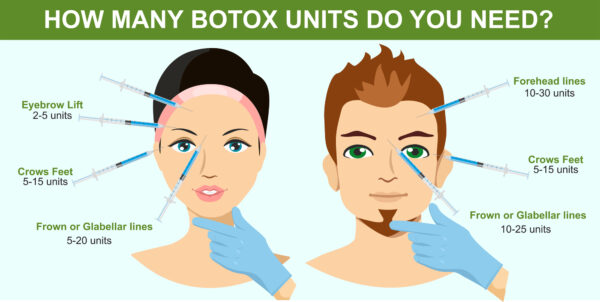
Botox dosage will be determined by factors such as the patient’s age, body mass index, and the severity of their wrinkles and muscle spasms.
One must be familiar with the recommended Botox dosage and injection sites before delivering the treatment. Individual differences in age, body mass index, and severity of wrinkles or muscle spasms will dictate dosing. When treating different areas, such as the forehead, crow’s feet, or neck, the injection locations will also change. If you want to administer Botox successfully, you need to have a firm grasp of facial and neck anatomy.
Keep tabs on patients and conduct regular checks
Monitoring the patient for unfavorable responses or side effects after Botox administration is essential. Examining the injection site for signs of inflammation, redness, or bruising is part of this process. The patient should be contacted after treatment is complete to gauge their level of satisfaction and address any remaining problems. Appointments for upkeep and dosing adjustments are essential for Botox to keep working as intended. Safe and effective Botox delivery, as well as a loyal patient following, can be achieved with careful patient monitoring and follow-up.
To ensure patient safety and the best possible treatment outcomes, only trained professionals should administer botox injections. Several fundamental approaches to remember when administering Botox are outlined below.
Consultation and Patient Evaluation:
- Learn everything you can about the patient’s current health situation, as well as their past treatments, drugs, and allergies.
- Choose the best injection locations and dosage by analyzing the patient’s facial anatomy, muscle strength, and skin condition.
- Talk to the patient about what they hope to achieve by receiving treatment and what they may experience as a result of it.
Reconstitution and storage procedures:
- Reconstitute the Botox powder according to the manufacturer’s instructions using a suitable diluent, typically sterile saline.
- Check the reconstituted Botox solution to make sure it is clear, colorless, and particle-free before applying it.
- To ensure the stability and efficacy of Botox, store the vials in a refrigerator at the recommended temperature.
Injection Technique:
- Find the exact muscles that cause the patient’s complaints, such as creases in the forehead, around the eyes, and the mouth.
- For accurate injections, a sterile needle with a tiny gauge should be used.
- Use the proper injection depth (intramuscular or subcutaneous) for the area being injected and the desired result.
- To avoid overdosing in one region, provide a series of tiny, evenly-spaced injections.
- To guarantee precise injection placement, you might think about using anatomical landmarks or grid patterns.
Medical personnel can learn the finer points of the Botox injection method through the training program Dentox. Get the knowledge required to comprehend cutting-edge techniques for improving the physical and mental health of your patients. To learn more about the online and live patient training sessions offered by Dentox, respectively, go to https://dentox.com/all-courses/botox-training and https://dentox.com/live-courses/.
A Total of 149 Botox Vials Were Seized by CBP Officers in Aguadilla, Puerto Rico


US Customs and Border Protection officials and import specialists found illegal Botox packages at Rafael Hernández International Airport.
Packages carrying illegal vials of Botox were discovered during a search at Rafael Hernández International Airport by US Customs and Border Protection officers and import specialists.
149 vials of Botulax were found in two packages transported from Seoul, Korea, in violation of the Food, Drug, and Cosmetic Act. Products with a domestic value of over $15,000 were confiscated.
The Port Director of Mayaguez-Aguadilla has remarked that the internet has made it easier to find and purchase items from all over the world. But many consumers are finding it far more difficult to get an item purchased abroad transported successfully to the United States. Importing anything into the United States necessitates going through Customs and Border Protection (CBP), where it could have to pay duties and comply with other rules and regulations depending on what it is.
The importation of botulinum toxin (also known as Botox) into the United States is prohibited without the appropriate documentation. The FDA regulates the importation of pharmaceuticals for human use into the United States to ensure they are safe and secure enough to be sold here.

The Food and Drug Administration (FDA) oversees the importation of drugs intended for human consumption into the United States.
To ensure the safety and security of the American people against illegal items, CBP enforces hundreds of laws for partner organizations like the Food and Drug Administration. When purchasing from an unknown vendor, consumers should be cognizant of the potential dangers posed by the product’s unknown components. For optimal results, consumers should use only FDA-approved cosmetics from trustworthy retailers and have only medical practitioners with appropriate credentials apply them.
CBP works hard to prevent the entry into the United States of products that pose a threat to public health and safety, American workers, children, and domestic plant and animal life. Most harmful or potentially harmful products don’t appear unsafe at first glance. Nevertheless, what you’re about to read will prove that initial impressions aren’t always right.
Dentox is a program designed to teach doctors and estheticians how to use Botox safely and effectively on their patients. If you want to improve your practice for your patients and grow your business, Dentox can help you gain the knowledge you need to do both.
Dr. Howard Katz is widely recognized as a leading expert on the topic of injectable training. He offers his classes in the traditional classroom environment as well as online and on demand. Visit https://dentox.com/all-courses/botox-training/ for online Botox training, and https://dentox.com/live-courses/ for training with real patients.
A Proven 12-Step Plan for Launching Your Own Botox Clinic

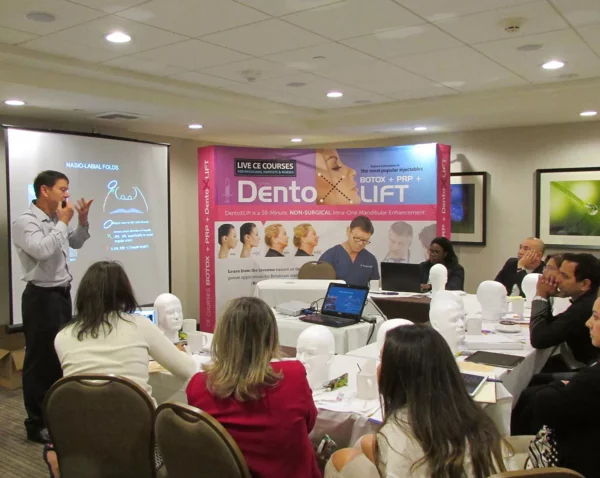
To learn how to inject Botox safely and successfully, you need to attend a reputable training program.
A well-organized and executed business plan is essential for opening a Botox clinic. If you want to start a successful practice, follow these ten guidelines.
1. Get the right credentials and education
Before you can legally inject Botox, you must first finish the necessary training and obtain the necessary certifications. Taking a Botox training course and getting a medical license or certification in your state are also necessary steps. Being trained to inject Botox safely and effectively requires enrolling in a respected training program. You can keep up with the most recent developments in your industry by participating in ongoing training and education courses.
Instructions for the injection of Botox are now being made available to medical practitioners. Courses can either be completed online at https://dentox.com/all-courses/ or in-person with real patients at https://dentox.com/live-courses/. Get the knowledge necessary to boost the patient’s quality of life by enhancing their overall look, their well-being, and their vision.
2. Learn the requisite laws and regulations
Become acquainted with the legal and regulatory framework that governs the use of Botox in your area and make sure you understand it. Be sure that you are in compliance with all of the criteria for documents, licenses, and permissions.
3. Establish a business network
Network with other medical professionals, such as dermatologists, plastic surgeons, and primary care physicians, who may recommend patients to your practice. These medical professionals might be able to refer patients to your office. Building Professional connections can be made through participation in seminars, local events, or professional associations.
4. Make an investment in top-notch tools and supplies
It is important to be prepared to inject Botox, so stock up on sterile needles, syringes, and other medical supplies. Having access to high-quality medical supplies and equipment is important for patient care and satisfaction.
5. Determine the location you will use
It is essential to the success of your Botox practice that you select the appropriate site. Consider how accessible it is, how noticeable you will be, and how much rivalry there will be in the area. You should search for a site that is conveniently accessible to the people who make up your target market. This could be a medical office building or a bustling retail complex. Visibility is another crucial factor to consider because you want prospective customers to be able to quickly locate and identify your clinic. Moreover, conduct research into the competition in the community to ascertain whether or not there is sufficient demand for your services and whether or not you can separate yourself from other service providers.
6. Acquire all required licenses and permits
It is crucial to make sure that you have all of the necessary licenses and permissions in order before starting your Botox clinic. This will vary based on both the location of your business and the particular services that you intend to provide. Verify your credentials with the appropriate medical board in your state to see if you are allowed to provide Botox injections. Also, it is possible that you will need to acquire a business license and register with the health authority in your area. Before you start your own practice, you need to be sure that you have done the necessary research and that you are in full compliance with all of the requirements. Visit https://dentox.com/medical-dental-and-nursing-state-boards/ for a list of state medical boards and their contact information.
7. Get the necessary equipment and supplies
Assuming you have your licenses and permits in order, the next step is to stock up on the equipment and supplies you’ll need to open for business as a Botox specialist. Needles, syringes, alcohol swabs, and Botox injectables are all examples of medical supplies. You’ll also need to buy things like a treatment table, a medical trolley, and some cupboards to put things in. If you care about your customers’ well-being and pleasure, you should invest in high-quality tools and supplies. If you want to have access to cutting-edge tools and equipment, it may be worthwhile to partner with a dependable provider.
8. Offer outstanding care to patients
Focus on providing excellent treatment for patients if you want to have a solid reputation. Offer discussions, listen to patient’s problems, and explain their next steps carefully. If patients are pleased with their care, they will tell others about it.
9. Be abreast with developments in your field
Learn as much as you can about cutting-edge science, practices, and discoveries in the field of aesthetic medicine. Improve your knowledge and abilities by participating in seminars, workshops, and online webinars. You need to continually learn new things if you want to stay competitive in your field.
10. Always be compliant and retain accurate records
Set up a reliable method of documenting all aspects of a patient’s medical care, from initial consultation to discharge. Respect privacy rules, data protection legislation, and professional ethics to maintain patient confidence and privacy.
11. Think about a marketing plan

Create a comprehensive marketing plan to attract and retain clients. Consider search engine optimization (SEO), online and social media advertising, and in-person events as examples of promotional strategies.
Develop an all-encompassing marketing strategy for gaining and keeping customers. Think about SEO (search engine optimization), internet and social media marketing, and local promotions. Emphasize your knowledge, precautions taken and successful past encounters with patients.
12. Prepare a business plan
Make a thorough business plan that includes your vision, mission, target audience, pricing, promotional initiatives, and projected earnings. A well-thought-out plan can serve as a guide for making crucial decisions and, if necessary, can help you convince investors to back your venture.
It’s important to remember that your Botox marketing won’t produce results overnight. Maintaining a high standard of excellence and putting patient safety first will draw in a steady stream of new clients to your practice.
Do Podiatrists Have the Authority to Prescribe Botox?


Podiatrists are medical professionals that focus on the diagnosis, treatment, and prevention of foot and ankle conditions.
Do podiatrists have the legal right to issue prescriptions for Botox? Are you interested in learning more about Botox injections and their possible advantages for foot-related conditions? This piece will dig into the specialty of podiatry and discuss whether or not podiatrists are permitted to give patients Botox.
Podiatry and Botox: What You Need to Know
To fully grasp the connection between podiatry and Botox, one must first know the field’s place in modern medicine. Podiatry, also referred to as podiatric medicine, is a branch of internal medicine that focuses on diagnosing, treating, and preventing diseases of the foot, ankle, and lower limbs. Podiatrists are medical experts who specialize in treating and preventing problems with the feet. They are essential to the general well-being of the foot.
Let’s learn more about Botox and why it’s important in podiatry. Botox, which is made from the bacterium Clostridium botulinum, has become immensely popular due to its wide range of uses in the cosmetic and medical fields. Although Botox is best known for its cosmetic benefits, it has also been shown to be effective in the treatment of a number of medical issues.
Botox has shown promise in other medical fields, and podiatry is no exception. The ability to reduce foot problems, such as those caused by muscle stiffness and excessive perspiration, is a major benefit. Muscle spasticity can cause discomfort from illnesses like plantar fasciitis and Achilles tendinitis, but Botox injections can help relax the muscles to alleviate the pain and restore movement. Additionally, hyperhidrosis, a condition characterized by excessive foot perspiration that can cause discomfort and fungal infections, responds well to Botox treatment.
While Botox may help with some foot problems, it is not a panacea. Patients should always check with a licensed podiatrist before deciding whether or not Botox treatment is right for them because every case is different. Podiatrists are in a prime position to assess the appropriateness of Botox injections and provide individualized treatment strategies due to their extensive knowledge of foot anatomy and biomechanics.
Professional Responsibility for Podiatrists
To put it simply, podiatrists are medical doctors who focus on the lower extremities, specifically the feet and ankles. They have the knowledge and skills to treat a wide variety of foot problems, thanks to their extensive training and education. Their scope covers:
- Diagnosis and Treatment: Conditions affecting the foot and ankle, from the relatively minor (bunions, ingrown toenails) to the significantly more serious (fractures, nerve disorders), are all within the scope of practice for podiatrists.
- Surgery of the foot and ankle: These specialists have received training in interventions to treat deformities, alleviate pain, and reclaim function.
- Wound Care and Diabetic Foot Management: Podiatrists are medical experts who focus on the feet and use cutting-edge methods to treat and prevent foot wounds, especially in diabetic patients.
- Sports medicine: They offer specialized treatment for foot and ankle injuries in athletes, assisting with their recovery, helping them avoid further injuries, and enhancing performance.
- Orthotics and biomechanics: Podiatrists examine biomechanical problems and apply orthotic devices to correct imbalances, enhance gait mechanics, and relieve pain.
Botox and its Potential Uses in Podiatry
In recent years, the medical benefits of Botox for podiatry have received as much notoriety as its cosmetic uses. It shows promise in the treatment of a range of foot disorders. Injections of Botox have been useful for treating:
- Feet hyperhidrosis: When you sweat a lot more than usual.
- Plantar Fasciitis: Heel pain brought on by plantar fascia inflammation
- Morton’s Neuroma: Thickening of tissue around the nerves leading to the toes
- Toe Deformities: Deformities of the toes, such as hammertoes and claw feet
- Chronic Ankle Pain: Constant discomfort around the ankle area
There are a number of potential advantages to using Botox in podiatry:
- Non-surgical Alternative: A non-invasive replacement for surgery
- Localized Treatment: Direct application to the site of the problem
- Temporary Relief: Effects provide only transient relief and last for several months.
- Enhanced Mobility: A better range of motion and general quality of life for the patients
Numerous case studies and patient testimonials have supported the effectiveness of Botox treatments in podiatry. Patients with persistent plantar fasciitis who received Botox injections noticed a substantial decrease in discomfort and an increase in function, according to a study published in the Journal of the American Podiatric Medical Association.
Considerations in Law and Regulation
To better understand the legal and regulatory issues that affect podiatrists when they prescribe Botox, let us look at the most salient points:
The Constitutional and Judicial Underpinnings
Podiatrists can only prescribe within the limits set by their home jurisdictions’ legal systems. Podiatrists may be able to prescribe medications independently in some areas, while in others they may need to be under the supervision of a medical doctor. Assuring compliance and protecting patients requires a thorough comprehension of the applicable legal framework.
Different Regulations
The scope of practice for podiatrists in terms of prescription authority varies widely between jurisdictions. While some jurisdictions may give podiatrists unrestricted authority to prescribe Botox, others may impose restrictions or mandate additional credentials. Podiatrists who want to stay within the law should study the rules that apply to their state or province of practice.
The best way to get accurate information right now is to get in touch with the medical board in your state. To locate the medical board in your state and their contact information, go to https://dentox.com/medical-dental-and-nursing-state-boards/.
Collaboration and Referral

In areas where podiatrists’ ability to prescribe medications is constrained, collaboration and referral networks become extremely crucial.
Collaboration and referral systems become especially important in nations where podiatrists’ prescribing authority is limited. To provide the best care possible for their patients, podiatrists sometimes work with other medical specialists like physicians and dermatologists. Podiatrists can refer their patients to the most qualified specialists through these networks.
Podiatrists who take part in specialized training and certification programs are better equipped to deliver Botox. Dentox can give you the education you need to improve both the quality of care you give your patients and the profitability of your practice. Online Botox training may be found at https://dentox.com/all-courses/botox-training/, while in-person training with live patients can be found at https://dentox.com/live-courses/.
When Should You Return to Working Out after Getting Botox?

The question “When to workout after Botox?” is among the most frequently asked by those considering the treatment. In the United States, Botox has surpassed all others as the most popular cosmetic procedure thanks to its effectiveness in delaying the visible effects of aging.
However, there are safety measures you should follow after getting Botox injections, like resting for 24 hours and abstaining from physically demanding activities. We have got you covered if you are curious about weight training and working out after getting Botox.
Just what is Botox?

Botulinum toxin, also known by the brand name Botox, is a neurotoxin that can temporarily relax muscles, resulting in less wrinkling.
Botox, which stands for “Botulinum Toxin,” is a neurotoxin used to temporarily relax muscles and thus reduce wrinkles. It is commonly used for both aesthetic and therapeutic purposes. Botox does not start showing its cosmetic benefits right after injection but rather over the course of a few days.
During the initial days and weeks after receiving Botox, it is essential to allow the treatment to take effect and avoid doing anything that might compromise the results.
Injecting Botulinum Toxin into a muscle causes temporary paralysis because it blocks a nerve signal that normally causes the muscle to contract. As a result of the muscle relaxation it induces, Botox is frequently used for cosmetic purposes, as it can lessen the appearance of wrinkles and prevent the formation of new ones.
Botox has medical applications beyond its more well-known cosmetic ones, including the treatment of migraines and temporomandibular joint disorders.
When Should You Return to Exercise After Getting Botox?
Although it is commonly recommended to wait at least 24 to 48 hours after Botox injections before working out, it is essential to consult with your healthcare provider or the expert who administered your Botox to get individualized advice.
After getting Botox, will I be able to continue lifting weights?
The effectiveness of Botox settlement or the likelihood of bruising at the site of injections could be negatively impacted by exercises involving heavy weight lifting and severe resistance training, which can increase blood pressure and blood flow.

After having Botox, facial expressions and physical activity can cause the substance to migrate from the injected muscles to unexpected locations.
Facial expressions and physical exertion could have an effect on the injected muscles after receiving Botox.
What Side Effects Does Working Out After Getting Botox Have?
Exercising too soon after a Botox injection can negatively affect the procedure’s effectiveness and increase the risk of complications. Some of the potential negative outcomes of exercising soon after receiving Botox include the following:
Botox migration: Engaging in strenuous physical activity, particularly those that call for repeatedly expressing or moving your face, may cause the Botox to migrate to unanticipated areas. Muscle wasting or paralysis in undesirable areas may consequently affect your appearance.
Reduced effectiveness: Due to the increase in blood flow that comes from exercise and strenuous physical activity, Botox may not be as effective. The neurotoxin requires some time to take effect in the desired muscles before it can produce the desired cosmetic results. Strenuous exercise soon after treatment may impede this process, diminishing the outcome.
Bruising or swelling: Intensive exercises, such as weightlifting or heavy sports, may elevate blood pressure and increase the likelihood of bruising or swelling at injection sites. This may affect the final result by elongating the recovery time.
Pain: Physical activity following Botox injections may result in pain or uncomfortable sensations at the targeted sites. Because of the increased strain and blood flow, any possible post-injection adverse effects, such as irritation or inflammation, might grow increasingly serious.
Maintaining an active lifestyle is vital to general health, but it is also essential that you follow the recommended waiting period before exercising after Botox treatment. You can get the best results from your Botox treatment while also continuing your regular exercise routine if you give the Botox time to settle and follow your healthcare provider’s directions.
Dentox is a course in which medical professionals are instructed in the safe and effective administration of Botox. Dentox can help you grow your business and provide better care to your present clientele.
It’s never too early to start taking a course from experts in the field of botox. If you put in the time to learn, you might ultimately be able to perform marvels for every person who walks through your door. In addition to the live courses offered at https://dentox.com/live-courses/, online Botox training is available at https://dentox.com/all-courses/botox-training/.
Improving Your Smile Makeover Outcomes With Botox® Injections


Botox® Cosmetic, a neuromodulator approved by the Food and Drug Administration, is commonly used to temporarily lessen the appearance of dynamic wrinkles and fine lines.
How Botox® injections can reduce the appearance of “gummy smiles” and wrinkles around the lips. Minimizing the appearance of fine lines and wrinkles is often the perfect complement to cosmetic dentistry and can have a profound impact on the overall youthfulness of a patient’s smile.
Botox is a fantastic, non-surgical option for those who want to reduce the signs of aging on their faces.
Smile Makeover With Botox
Although these treatments can greatly improve your oral health, they do not do much to improve your outward appearance. Your skin’s suppleness will decrease with age. Fine lines (also known as “smile lines”) appear around the mouth and elsewhere as a result of aging, UV exposure, gravity, and dehydration. Eventually, they will become deeper wrinkles that age your appearance.
Changing the shade of teeth, fixing chips and cracks, filling in gaps, and aligning crooked teeth are all important, but restoring volume to the gums and lips is just as crucial. While Botox injections on their own can have a rejuvenating effect, the results from combining them with cosmetic dental work are truly remarkable. A whiter, straighter, and brighter smile, along with anti-wrinkle treatments and lip fillers, can remove years from your appearance.
FDA-approved Botox® Cosmetic is widely used to temporarily reduce the look of dynamic wrinkles and fine lines. These lines are a result of both the aging process and the repeated folding and squishing of the face. Botulinum toxin type A, the major active component of Botox® Cosmetic, functions by momentarily inhibiting nerve and muscle signals. The muscles close to the injection site relax as a result and stop contracting. Botulinum toxin type A functions by momentarily obstructing impulses from the nerves to the muscles. This results in the muscles close to the injection site relaxing and ceasing to contract. As a result, existing folds relax and fade, and no new lines emerge.
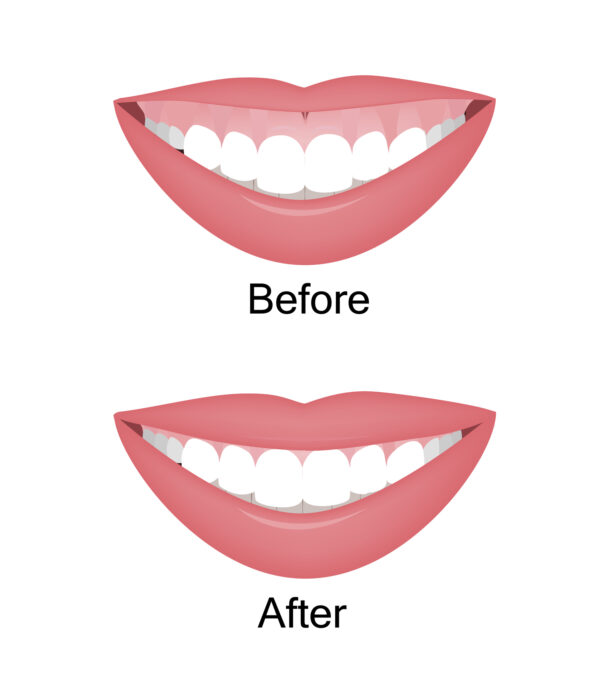
A “gummy smile,” one in which there is an abnormally large amount of gum tissue, can be addressed with Botox® injections.
By relaxing the upper lip and reducing how much of the gum line is visible when a patient smiles, Botox® injections can diminish the appearance of a “gummy smile,” which is a smile characterized by excessive gum tissue. Additionally, Botox® injections can lessen the pain in the jaw joints brought on by TMJ dysfunction.
While the majority of patients who get a smile makeover are delighted with the results, some become dissatisfied due to the persistence of wrinkles in those areas. Combining Botox® injections with cosmetic dental procedures like porcelain veneers and teeth whitening can frequently result in a more all-around revitalization. In addition, improving the aesthetics of a patient’s smile and reducing the appearance of wrinkles on the face might have the added benefit of making the patient appear younger.
Finding a skilled injector with a proven track record of delivering great aesthetic outcomes is essential for patients considering Botox® injections as part of their cosmetic dentistry treatment plan. Patients’ safety, comfort, and satisfaction can all be maximized in this way.
Trained medical professionals can inject the right amount of Botox. They are well-versed in the most efficient delivery methods. Dentox is an educational program that teaches doctors and estheticians how to safely and effectively inject Botox.
It is now possible for doctors and nurses to take courses in administering Botox and fillers. Both online and in-person Botox training classes may be found at https://dentox.com/all-courses/botox-training/ and https://dentox.com/live-courses/ respectively. Keeping up with the latest developments in Botox and providing your patients with the finest care possible requires constant learning of new treatments.
Here’s How “TrapTox” Can Improve Your Posture
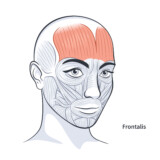
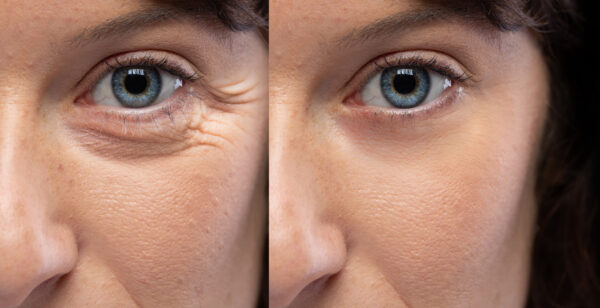
It is well-known that neurotoxins like Botox, Alluzience, Azzalure, and Bocouture can be effectively used to cure face wrinkles like frown lines and crow’s feet.
The use of neurotoxins such as Botox, Alluzience, Azzalure, and Bocouture in facial treatments for wrinkles like the forehead and crow’s feet is common knowledge. The FDA has also green-lighted their use for halting migraines and reducing sweating under the arms. Off-license practitioners are also using neurotoxins to treat posture, and the practice is gaining popularity as more and more people share videos about it on TikTok under the hashtag #TrapTox.
Injecting a product like Botox into problem areas of the body can help relieve postural issues by relaxing the targeted muscles. The trapezius muscle (or ‘trap’) is the most commonly targeted muscle when using neurotoxins for postural purposes, according to scientific literature. Many people refer to this procedure by the name “TrapTox” or “Trap Botox” when discussing it online.
What exactly does the treatment entail, though?
In what ways can “TrapTox” improve one’s posture?
Simply put, the procedure involves working on the muscles in your neck and shoulders, which causes you to stand up straighter because it is harder to continue slouching and, as a bonus, can result in a longer-looking neck and more defined shoulders. It is not a brand-new procedure, but few have heard of it; this suggests it is more widely sought after in Asia, where its slimming effect on the shoulders is prized. In this case, however, it seems that better posture is being highlighted as a means of alleviating tension-related pain and enhancing overall appearance.
Many of us spend hours a day slouched over a computer, which contributes to poor posture and the development of chronic pain in the shoulders and neck. Our cell phones are a major issue as well. The strain on the head and neck caused by smartphones is a significant issue that will continue into the future.
Muscle tension and poor posture can both benefit from neurotoxin injections, but only under certain conditions. There are currently no publicly available guidelines regarding how much to inject into these muscle groups or how to distribute doses. A procedure with Botox [or a similar product] for muscular tension could necessitate a minimum of two rounds. You should be selective about where you get injected for posture, as large muscle groups like the trapezius, as well as the upper body and neck, may need quite a significant amount to get the intended result. Given the quantity of neurotoxin required for bilateral administration, this could be an expensive treatment option.
Is ‘TrapTox’ appropriate for anyone?
It is ideal for people whose trapezius muscles are overly developed and who experience pain as a result of their habitual hunched posture. Though it can alleviate the distress brought on by these habits, you should know that this is not a permanent solution. It may be unpleasant as it begins to take effect, particularly if you attempt to slouch but are unable to do so.
Like any medical procedure, assessing your condition and discussing the pros and cons of treatment with a qualified professional who has extensive knowledge of the musculoskeletal system is essential.
Only trained professionals who are aware of the particular risks associated with each injection site should administer botox injections. They know how to assess an individual’s Botox needs, administer the right dose, and increase the treatment’s efficacy while minimizing the risk of adverse events.
Dentox simplifies the process of learning how to administer Botox injections, particularly in high-risk areas, to medical practitioners. Sign up for a seminar at one of our many convenient U.S. locations, or join a live, online, or on-demand session instead. You can learn more about our in-person and virtual training opportunities at https://dentox.com/live-courses/ and https://dentox.com/all-courses/botox-training/.
How to Avoid a Spock Brow and Ptosis with Botox Eyebrow Lift Injections
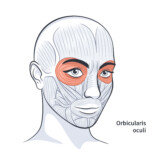
Have you ever wanted to know how to perfect the art of raising one’s eyebrows?
Botox Eyebrow Lifting Procedure
The orbicularis oculi, a muscle responsible for restricting and drawing down the eyebrow, can be targeted for a minimally effective eyebrow lift. Injecting the brow-lowering muscle is a viable treatment option for lateral brow furrows. There is a low risk and few adverse effects associated with injecting 4 units of Botox into the brow’s tail, which will have an effect on the orbicularis oculi muscle superiorly and laterally to provide a slight lift.
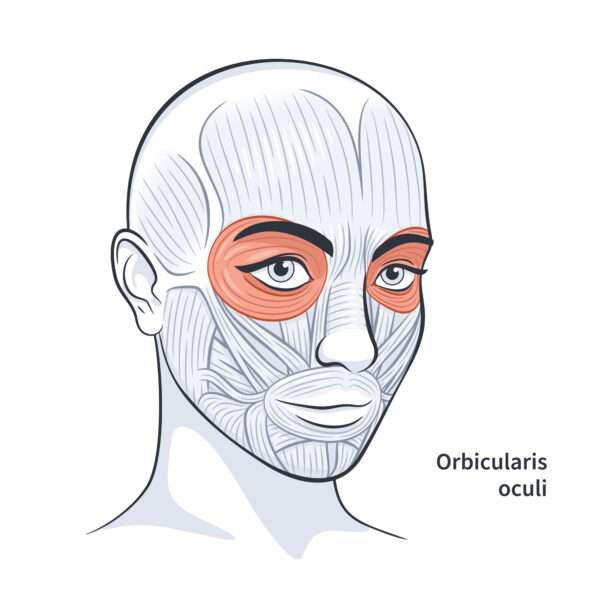
A minimally successful eyebrow lift targets the orbicularis oculi, which restricts and draws down the eyebrow.
More of the orbicularis oculi muscle can be treated by injecting 1 unit medially, underneath the eyebrow, always very superficially, and beneath the lateral part of the eyebrow. This will make it possible to get more of a lift while maintaining a very understated look.
Botulinum toxin injections into the medial frontalis can boost eyebrow lift by making the lateral frontalis muscle more toned at rest. It’s one of the most noticeable ways to show you’re interested.
Avoiding a Spock Brow
Treating the frontalis muscle alone can result in an unnaturally high frown and a lateral brow lift (also known as a “Spock brow”) if the underlying glabellar complex isn’t addressed as well. This is because the corrugator and the procerus are strong enough to depress the brows in most patients, though not all. Even if you are successful in keeping your patient’s brow from furrowing, they could nevertheless wind up seeming irritated even though they are not. This occurs regardless of whether or not the glabellar complex is targeted for treatment, if the medial frontalis is overworked. The root cause is a collapse in the brow’s medial support.
Use the Frontalis Muscle for a Botulinum Toxin Brow Lift
Draw a line beginning at the nasal ala, continuing through the inner corner of each eye, and then up and over the brow bone to the hairline. If you want your eyebrows to curve upward, you need to increase the activity of the frontalis muscle along this line.
Undertreatment of the frontalis can lead to the development of vertical lines across the forehead; to avoid this, it is necessary to sculpt the area of unused muscle so that it lifts without forming lines.
Seeing the direction of the vector you’re trying to amplify is made easier by the line drawn up to the hairline. Then, connect the dot to the location of the brow’s tail with a line, and connect the hairline to a point midway between the two. Botulinum toxin should not be used in this triangular area because it could weaken the lateral frontalis muscle.
To avoid treating other probable frontalis muscle locations as well, it’s critical to rule out any other possibilities. Leaving the frontalis muscle active in its lower third is helpful for avoiding medial brow ptosis. By drawing a line two centimeters out from the orbital ridge, we establish a buffer zone of untreated frontalis. Since lines rarely affect the lower third of the forehead, it is safe to leave this area untreated to support the middle of the forehead.
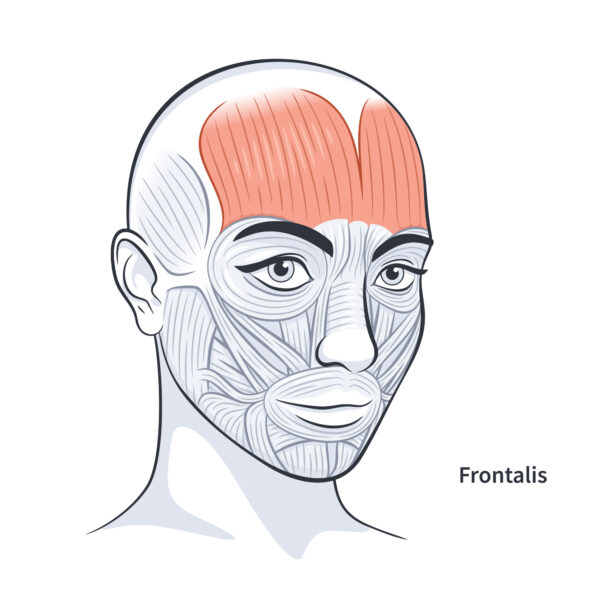
If you want to prevent medial brow ptosis, it’s best to keep the frontalis muscle active only in its bottom third.
If you want to “save” some money and time when using botulinum toxin, it’s a good idea to map out the areas of the forehead without frontalis muscles so you can be sure you’re only injecting the toxin into the muscles you want to affect.
Keeping all of this in mind, the only part of the frontalis muscle that should be left to relax with Botox is the medial part, since the parts needed to support the medial brow and lift the lateral brow have already been excluded.
Spread your injection locations appropriately and maintain symmetry for maximum effectiveness and ideal spread. A dose of 1-2 units of Botox has a circumferential spread or effect on the muscle of 1.5 cm, around the size of a marble. The relative size of the untreated muscle might alter significantly depending on the location of your lateral injections, which will have a significant impact on the relative size of the lift and result in uneven eyebrows that are quite obvious if the face is symmetrical.
By injecting 1 unit of Botox into the bottom of the triangle you formed at the hairline, you can lessen the lift if it is still too noticeable after two weeks. You can get even more lift by treating the orbicularis oculi at your second appointment if you skipped it the first time around in favor of the more visible glabellar and frontalis areas. When you’re treating a patient for the first time, you’re both learning, and it’s normal to make adjustments as you establish a pattern for their unique eyebrow lift and gain familiarity with their face.
Dentox offers a training program where you can learn the ins and outs of Botox administration. In the field of cosmetic and therapeutic injectables, Dr. Howard Katz is without peer as the most knowledgeable and experienced expert trainer. Learn from us, and you’ll be able to give your patients results that will blow away industry norms and leave them speechless.
Attend a seminar in person at one of many locations across the United States, or sign up for a course that is offered live, online, or on demand. Check out https://dentox.com/live-courses/ and https://all-courses.dentox.com/botox-training/ for more details on our in-person and online training opportunities, respectively.





